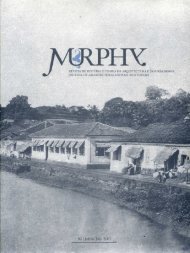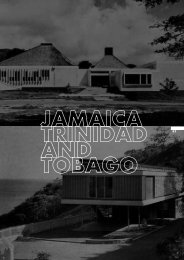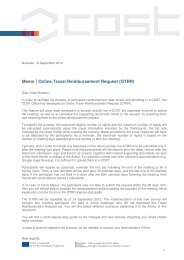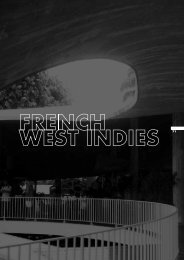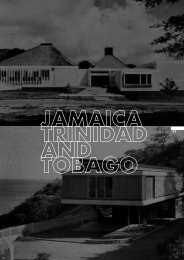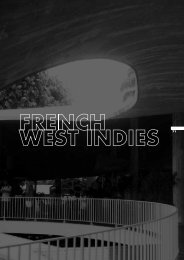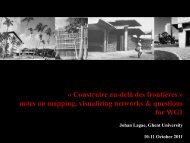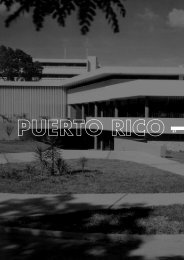Santo Domingo, Modernity and Dictatorship
Santo Domingo, Modernity and Dictatorship
Santo Domingo, Modernity and Dictatorship
You also want an ePaper? Increase the reach of your titles
YUMPU automatically turns print PDFs into web optimized ePapers that Google loves.
<strong>Santo</strong> <strong>Domingo</strong>,<br />
<strong>Modernity</strong><br />
<strong>and</strong> <strong>Dictatorship</strong><br />
OMAR RANCIER<br />
In the early twentieth century, <strong>Santo</strong> <strong>Domingo</strong> was a small village.<br />
When it burst its original limits of the colonial wall <strong>and</strong> of the villages<br />
of San Carlos to the North <strong>and</strong> of Pajarito on the east bank of the Ozama<br />
River, those peripheral settlements became part of the Republic’s capital.<br />
AT THAT TIME, the modern movement was underdeveloped<br />
in <strong>Santo</strong> <strong>Domingo</strong>. Meanwhile, the European masters were<br />
carrying out their works <strong>and</strong> the bauhauslers, who had<br />
fled the nazis <strong>and</strong> settled in the United States, participated<br />
in a process by which the total social content of modernity<br />
was lost, according to Colin Rowe. 1<br />
After nine years of the Trujillo nightmare the city changed<br />
its name to Ciudad Trujillo. This change was marked by<br />
the first consistently modern structure, the Copello<br />
building, erected in the emblematic Calle El Conde in<br />
1939. Thus, modernity came to <strong>Santo</strong> <strong>Domingo</strong> during<br />
the m<strong>and</strong>ate of Rafael Leonidas Trujillo Molina, the<br />
dictator who held Dominican society in his fist for three<br />
decades from 1930 to 1961. In his own person Trujillo<br />
assumed the role which the amorphous Dominican<br />
bourgeoisie did not take on, a pattern that became the<br />
usual strategy of other contemporary Latin American<br />
dictators: Pérez Jiménez in Venezuela, Machado <strong>and</strong><br />
Batista in Cuba, <strong>and</strong> Perón in Argentina. <strong>Santo</strong> <strong>Domingo</strong><br />
initiated its major modern urban projects, dividing them<br />
into two major divisions: on the one h<strong>and</strong>, public housing<br />
projects, such as the Barrios Obreros (Henry Gazón), 2 the<br />
Barrio of Maria Auziladora to the north of the city <strong>and</strong> the<br />
Barrio of Los Mina (Ramón Báez López-Penha <strong>and</strong> Pablo<br />
Mella) in the center, <strong>and</strong> on the other h<strong>and</strong>, institutional<br />
projects like the University City (José Antonio Caro<br />
Alvarez, Humberto Ruiz Castillo <strong>and</strong> André Dunoyer<br />
de Segonzac). The Fair of Peace <strong>and</strong> Fraternity of the<br />
Free World (Guillermo González), Caro’s Medical<br />
School <strong>and</strong> González’s Governmental Palace of the<br />
Federal District are emblematic works of the Dominican<br />
modern movement. Other relevant urban works are the<br />
Malecón, an enormous urban space more than twenty<br />
kilometers long, also known as the George Washington,<br />
which preserved the city’s seascape, Máximo Gómez<br />
Avenue <strong>and</strong> Fabré Gefrard Avenue <strong>and</strong> other<br />
thoroughfares, which created the first north-south axes of<br />
<strong>Santo</strong> <strong>Domingo</strong>. All these works were directed by<br />
engineer Ramón Báez López-Penha.<br />
ONLY IN THE MID 1950s, with the Regulating Plan of<br />
Ciudad Trujillo drawn up by Ramón Vargas Mera, does<br />
a vision of a modern city for <strong>Santo</strong> <strong>Domingo</strong> appear. This<br />
is in spite of two urban plans for the city, more<br />
neoclassical than modern, one of which was conceived<br />
by Guido D’Aless<strong>and</strong>ro <strong>and</strong> José Antonio Caro in 1937, 3<br />
<strong>and</strong> the other by José Ramón Lopez-Penha (1938).<br />
Virgilio Vercelloni called Lopez-Penha’s plan ‘comical<br />
<strong>and</strong> banal.’ 4 <strong>Modernity</strong> is impeded by the need to satisfy<br />
the central <strong>and</strong> hegemonic powers. So, on the one h<strong>and</strong>,<br />
projects are executed which attempt to make the city<br />
more efficient <strong>and</strong> which fulfill the requirements of<br />
motorized transportation, <strong>and</strong> on the other h<strong>and</strong>, which<br />
render the city a medium to promote the dictatorship’s<br />
power <strong>and</strong> presence.<br />
THE CREATION of a formal repertory 5 made of a full<br />
neoclassical catalogue is conceived by Henry Gazón. 6 It<br />
extends the regime’s power, from the capital to the distant<br />
<strong>and</strong> troubled frontier with Haiti.<br />
PERHAPS one of the most interesting aspects of the<br />
transition to modernity in the Dominican Republic under<br />
Trujillo’s rule is the use of a double code. This enabled<br />
53<br />
Docomomo N°33<br />
September 2005



